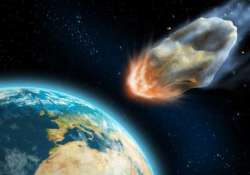Asteroid to have a close brush with Earth on Feb 16
Kolkata, Jan 31 : A piece of rock will have a close encounter with the Earth Feb 16, coming closer than some of the geostationary satellites orbiting the planet, said an official.The near earth asteroid,

Kolkata, Jan 31 : A piece of rock will have a close encounter with the Earth Feb 16, coming closer than some of the geostationary satellites orbiting the planet, said an official.
The near earth asteroid, 2012 DA14, about 148 metre in diameter, is on a close encounter course with the planet, and will come closest at around 12.55 a.m. Feb 16, according to Debiposad Duari, director, Research and Academic M.P. Birla Institute of Fundamental Research, of the M.P. Birla Planetarium here.
"At the point of closest approach, its distance will be about 34,100 km from the centre of the Earth.
"Given the radius of the Earth, it will be about 28,000 km from its surface, a small distance in terms of astronomical figures," Duari said in a statement.
The asteroid was discovered in an observatory in Spain Feb 23 last year, a week later when it passed close to the Earth at a distance of 1.6 million km.
"The orbital period of the asteroid was 366 days, and that is the reason, exactly after one year Feb 15 it is coming close to earth - mush closer than the previous years," Duari said.
The 130,000 metric ton massive rock will undergo a change in its period due to the close encounter with the Earth, and the approach will reduce the orbital period of the asteroid from 366 days to 317 days.
"Calculations by astronomers have shown that there is no possibility of this asteroid actually hitting the Earth, but it will pass closer to earth compared to some of the geosynchronous orbits of certain satellite," he said.
The geostationary satellites orbit at a distance of 95 km from each other, so, there is not much of a chance that the asteroid may hit one such satellite.
The next close approach will be Feb 16, 2046 when it will pass no closer than 60,000 km from the centre of the earth.
The asteroid will not be visible through the naked eye, but as Feb 15 draws closer, it can be viewed through a medium size telescope.
The Goldstone Deep space Communication complex in California will keep a constant watch on the asteroid from Feb 16 through Feb 20, trying to get more information about its orbit.
"If it were to hit Earth, it is estimated that it would have produced an explosion equivalent of 2.5 megatons of TNT," Duari said.
"Such events remind us, from time to time, our position and environment in space, the solar system, and objects associated with it, which can be considered our neighbours," he added.
The near earth asteroid, 2012 DA14, about 148 metre in diameter, is on a close encounter course with the planet, and will come closest at around 12.55 a.m. Feb 16, according to Debiposad Duari, director, Research and Academic M.P. Birla Institute of Fundamental Research, of the M.P. Birla Planetarium here.
"At the point of closest approach, its distance will be about 34,100 km from the centre of the Earth.
"Given the radius of the Earth, it will be about 28,000 km from its surface, a small distance in terms of astronomical figures," Duari said in a statement.
The asteroid was discovered in an observatory in Spain Feb 23 last year, a week later when it passed close to the Earth at a distance of 1.6 million km.
"The orbital period of the asteroid was 366 days, and that is the reason, exactly after one year Feb 15 it is coming close to earth - mush closer than the previous years," Duari said.
The 130,000 metric ton massive rock will undergo a change in its period due to the close encounter with the Earth, and the approach will reduce the orbital period of the asteroid from 366 days to 317 days.
"Calculations by astronomers have shown that there is no possibility of this asteroid actually hitting the Earth, but it will pass closer to earth compared to some of the geosynchronous orbits of certain satellite," he said.
The geostationary satellites orbit at a distance of 95 km from each other, so, there is not much of a chance that the asteroid may hit one such satellite.
The next close approach will be Feb 16, 2046 when it will pass no closer than 60,000 km from the centre of the earth.
The asteroid will not be visible through the naked eye, but as Feb 15 draws closer, it can be viewed through a medium size telescope.
The Goldstone Deep space Communication complex in California will keep a constant watch on the asteroid from Feb 16 through Feb 20, trying to get more information about its orbit.
"If it were to hit Earth, it is estimated that it would have produced an explosion equivalent of 2.5 megatons of TNT," Duari said.
"Such events remind us, from time to time, our position and environment in space, the solar system, and objects associated with it, which can be considered our neighbours," he added.